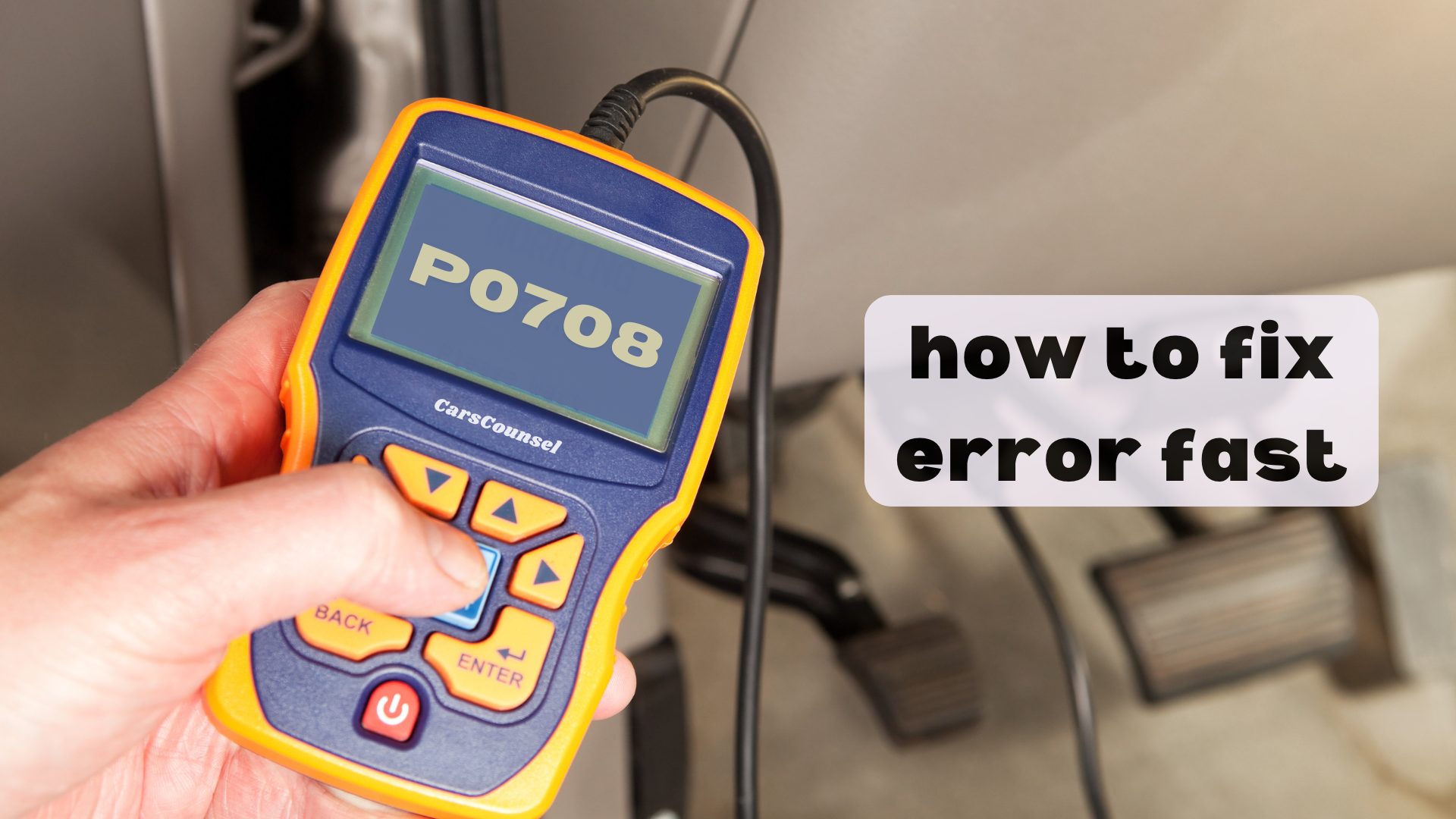Imagine you’re driving your Honda Accord, and suddenly the check engine light comes on with a P0708 code. This usually means there’s an issue with the transmission range sensor.
First, use an OBD-II code reader to confirm the error code. Then, check the sensor and wiring for any visible damage or corrosion. If you find any issues, repair or replace the damaged parts.
Also, make sure the transmission fluid is at the right level and in good condition.
What else should you do to ensure your car runs smoothly again?

Quick Navigation
Key Takeaways
- Use an OBD-II code reader to confirm the P0708 error code.
- Look for and fix any damaged wires or corroded connectors in the transmission range sensor circuit.
- Make sure the transmission fluid is at the right level and in good condition.
- If needed, replace the faulty transmission range sensor and make sure it’s installed correctly.
What Is the P0708 Code
The P0708 code means there’s a problem with the transmission range sensor circuit, which affects the signals sent to the Transmission Control Module (TCM) about your gear position. This trouble code usually indicates transmission issues caused by sensor failures.
When the sensor doesn’t work properly, the TCM gets wrong or no information about gear selection, leading to bad shifting and possible transmission failure. This can cause serious problems like unexpected engine stalling, erratic speedometer readings, and the check engine light coming on.
It’s important to address the P0708 code quickly to keep your vehicle running well and avoid bigger transmission problems. Knowing about this code helps you find and fix the issue, ensuring your transmission lasts longer.
Common Causes of P0708
To fix the P0708 code, you need to know its common causes, which usually include a bad transmission range sensor or damaged wiring.
Testing the sensor is crucial because a broken sensor can send wrong signals to the Transmission Control Module (TCM).
Also, checking the wiring is important since heat or wear can damage it and mess up the sensor’s job.
Other possible issues are a faulty TCM that reads sensor signals incorrectly, blown fuses that cut power to the TCM, and low transmission fluid levels that hurt overall transmission performance.
Recognizing P0708 Symptoms
Spotting P0708 symptoms early can save you from major transmission problems and expensive repairs.
Look out for trouble shifting gears, as this indicates your transmission isn’t working right. You might also notice your engine stalling unexpectedly, which could mean there are issues with the sensor.
Erratic speedometer readings suggest the transmission range sensor isn’t sending the correct signals.
Dashboard warning lights, especially the Check Engine Light (CEL), are important alerts. If your vehicle goes into failsafe or limp mode, its performance will be greatly reduced, signaling that it needs immediate attention.
Tools for Diagnosing P0708
To accurately diagnose the P0708 code, you’ll need some specific tools.
Start with an OBD-II code reader to check if the P0708 code is present.
Then, use a multimeter to test voltage and measure resistance in the transmission range sensor circuit.
Don’t forget to visually inspect connectors and wiring.
A scan tool that can read live data from the Transmission Control Module (TCM) and other related systems is also very useful.
Lastly, have the service manual for your vehicle handy to ensure you follow the correct diagnostic steps and refer to wiring diagrams.
Steps to Diagnose P0708
To diagnose the P0708 code, start by connecting an OBD-II code reader to the car’s diagnostic port to confirm the code is present.
Then, visually check for any corroded connectors, damaged wires, or loose connections.
Next, use a multimeter to check the voltage and resistance of the transmission range sensor to make sure it’s working correctly.
Also, check the transmission fluid levels and condition since low fluid can affect how the transmission works.
Finally, look at the Transmission Control Module (TCM) for any faults or needed software updates.
These steps will help you find the cause of the P0708 code and fix it effectively.
Fixing Damaged Wiring
Fixing Damaged Wiring
After figuring out that the P0708 code might be due to damaged wiring, you should focus on fixing the bad wires to get the transmission working right again.
First, disconnect the car’s battery to stay safe from electrical shocks.
Use good wiring methods like soldering the connections and covering them with heat shrink tubing to fix any frayed or broken wires.
Check the wiring harness for signs of heat damage or rust, and replace any damaged parts.
Make sure all connections are tight and well-insulated to avoid future problems.
Finally, reconnect the battery and test the system to see if the P0708 code is gone.
This step-by-step approach will help keep your car’s electrical system in good shape.
Replacing the Sensor
When the transmission range sensor isn’t working right, it’s important to replace it to make sure your gears work properly and to avoid more transmission problems.
First, find the bad sensor, which is usually near the transmission. Disconnect the battery to stay safe from electrical shocks. Check to make sure the sensor is really the problem before you start replacing it.
After that, carefully take out the old sensor, remembering how it was positioned and connected. Put in the new sensor, making sure it lines up the same way as the old one.
Reconnect everything and attach the battery again. To make sure everything’s working, run a diagnostic check with an OBD-II scanner.
Proper installation is crucial for the gears to signal correctly to the transmission control module (TCM). Follow these steps to replace the sensor and fix the P0708 code.
Reprogramming the TCM
Reprogramming the TCM (Transmission Control Module) makes sure the new transmission range sensor works correctly, ensuring smooth gear changes and good vehicle performance. After you replace the sensor, it’s crucial to reprogram the TCM so it matches the vehicle’s system. You’ll need special tools and software for this, which you can usually get from the car maker or authorized service centers.
| Feeling | Technical Benefit |
|---|---|
| Relief | Smooth gear changes |
| Confidence | Better vehicle performance |
| Satisfaction | Correct sensor settings |
Doing TCM programming the right way prevents more transmission problems and makes driving more reliable. Always follow the manufacturer’s instructions to get the best results.
Managing Transmission Fluid
Taking care of your transmission fluid is really important to keep your car’s transmission running smoothly. Different cars need different types of transmission fluid, so always use the kind recommended by the manufacturer.
Changing the fluid regularly stops it from getting dirty and helps your transmission work its best. Here are some easy steps to follow:
- Check the Fluid Level: Use the dipstick to make sure the fluid is at the right level.
- Look at the Fluid: Good fluid is usually red and should be clean.
- Change the Fluid Regularly: Follow your car’s maintenance schedule for when to change the fluid.
- Watch for Leaks: Check often to see if there are any fluid leaks.
Preventive Maintenance Tips
Taking care of your car’s transmission fluid is just one part of making sure your vehicle runs smoothly and efficiently. Sticking to a regular maintenance schedule is important. By taking preventive steps, you can avoid issues like the P0708 code and other transmission problems.
Here’s a quick reference table:
| Task | How Often |
|---|---|
| Check Transmission Fluid | Every 30,000 miles |
| Replace Transmission Fluid | Every 60,000 miles |
| Inspect Wiring & Connectors | Every 12 months |
| Test Transmission Range Sensor | Every 24 months |
| Update TCM Software | As per manufacturer |
More OBD-II Codes
Frequently Asked Questions
Can Driving With a P0708 Code Cause Long-Term Damage to My Transmission?
Yes, driving with a P0708 code can damage your transmission over time. You might notice problems like rough shifting and stalling. To avoid more issues, check the wiring, sensor function, and fluid levels.
Are There Any Specific Models or Years More Prone to the P0708 Code?
You’re asking about different car models and years being more likely to show the P0708 code. Generally, older cars with automatic transmissions, especially those from the early 2000s, are more prone to this issue. This is often due to wear and older sensor technology. Keeping up with regular maintenance can help prevent this problem.
How Much Does It Typically Cost to Fix a P0708 Code?
Fixing a P0708 code usually costs between $150 and $400. Repairs might involve replacing the sensor, fixing the wiring, or reprogramming the transmission control module (TCM). You’ll need tools like an OBD-II reader and a multimeter to diagnose the problem accurately.
Can a P0708 Code Affect My Vehicle’s Fuel Efficiency?
Think of your vehicle like a well-coordinated orchestra. A P0708 code can throw things off, causing your transmission to perform poorly. This can lead to higher fuel consumption and reduce your vehicle’s fuel efficiency.
What Should I Do if the P0708 Code Reappears After Repairs?
If the P0708 code shows up again after you’ve made repairs, double-check all your tools and the steps you took. Make sure the wiring is in good shape, the sensor is properly installed, and there are no issues with the TCM. If you’re still having trouble, it might be a good idea to get a professional to take another look.
Conclusion
Got the P0708 code? With the right tools and steps, you can fix it quickly.
Use an OBD-II reader to diagnose the issue, inspect and repair any damaged parts, check the transmission fluid, and reprogram the Transmission Control Module (TCM) if needed.
Taking these steps will help keep your vehicle running smoothly.
By following these guidelines and maintaining your transmission, you’ll keep your car in top shape and avoid future problems.

